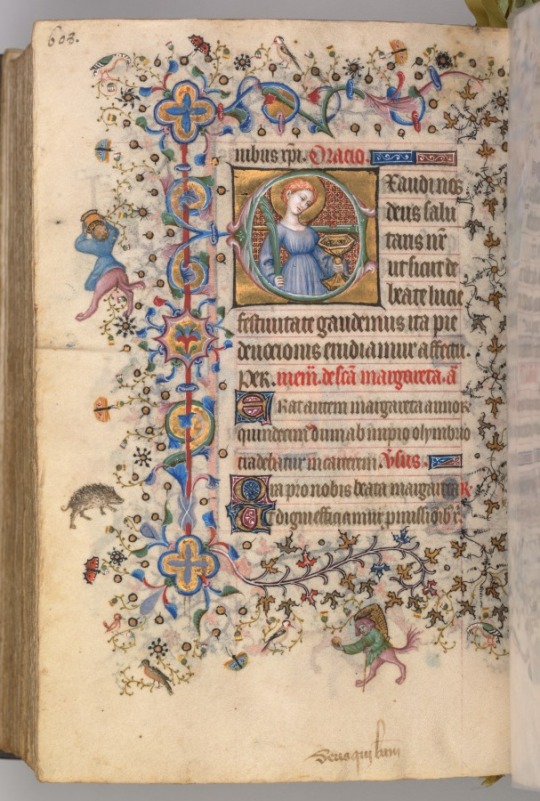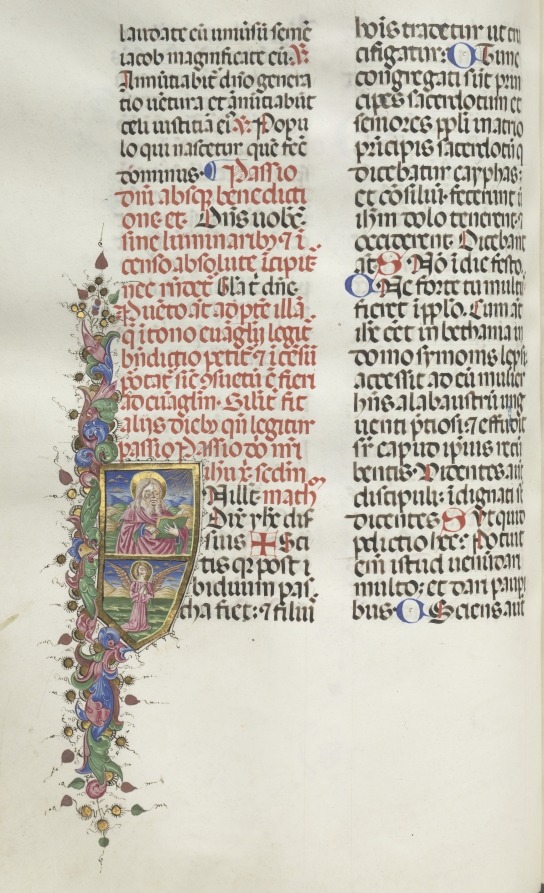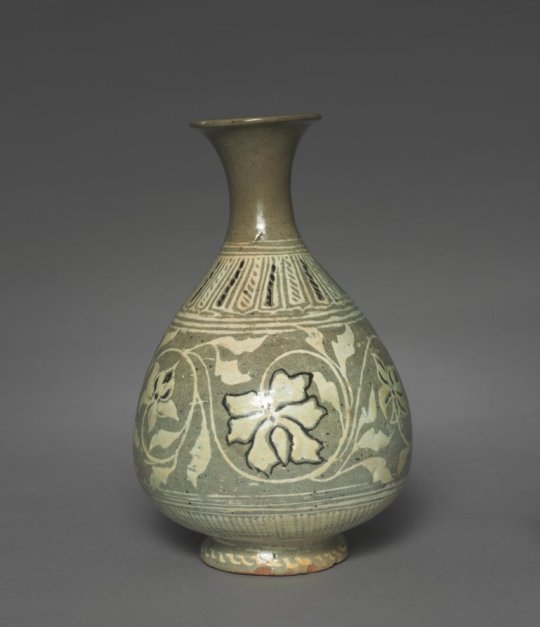Sharing public domain works from the Medieval Art department of the Cleveland Museum of Art
Don't wanna be here? Send us removal request.
Photo

Figurine of Demeter with Pig, 400s BC, Cleveland Museum of Art: Greek and Roman Art
Size: Overall: 20 cm (7 7/8 in.) Medium: terracotta
https://clevelandart.org/art/1926.521
144 notes
·
View notes
Photo

Hours of Charles the Noble, King of Navarre (1361-1425), fol. 298v, St. Lucy, Master of the Brussels Initials and Associates, c. 1405, Cleveland Museum of Art: Medieval Art
This precious volume was obviously highly prized by its owner, the French-born King of Navarre, who had his coat of arms painted on no less than twenty folios. Rather than directly commissioning this manuscript from a specific workshop, it seems that Charles the Noble acquired his book of hours -- perhaps ready-made for the luxury market -- while on a trip to Paris in 1404-05. A collaborative effort, six painting styles are evidenced within the pages of this codex, those of two Italians, two Frenchmen, and two Netherlanders. The painter who was responsible for the planning and decoration of the book, and who produced seventeen of the large miniatures, was a Bolognese artist known as the Master of the Brussels Initials. His principal assistant, responsible for most of the borders, was a Florentine who signed his name "Zecho" da Firenze on folio 208 verso. Size: Codex: 20.3 x 15.7 x 7 cm (8 x 6 3/16 x 2 3/4 in.) Medium: ink, tempera, and gold on vellum
https://clevelandart.org/art/1964.40.298.b
45 notes
·
View notes
Photo

The Gotha Missal: Fol. 111r, Text, Master of the Boqueteaux, c. 1375, Cleveland Museum of Art: Medieval Art
This elegant Latin manuscript is known today as The Gotha Missal after its eighteenth-century owners, the German Dukes of Gotha. The volume was originally copied and illuminated in Paris around 1375 -- a commission of the Valois king, Charles V "the Wise" (1364-1380), one of the great bibliophiles of the fifteenth century and brother of Dukes Philip the Bold of Burgundy and Jean de Berry. Manuscript missals were not intended for the lay user, but rather for the use of the celebrant at Mass. The present volume was therefore meant to be used by the king's private chaplain and was probably housed in Charles's private chapel, possibly in his principle residence, the Palace of the Louvre (demolished in the sixteenth century). The main decorative body of the missal consists of two full-page miniatures comprising the Canon of the Mass and twenty-three small miniatures. The style and high quality of the decoration points to its inclusion withing a select group of manuscripts accepted today as from the hand of Jean Bondol. Bondol was active at the court of Charles V from 1368 until 1381 where he headed the court workshop and also served as the king's valet de chambre. The blind-tooled leather binding dates to the fifteenth century. Size: Codex: 27.1 x 19.5 cm (10 11/16 x 7 11/16 in.) Medium: ink, tempera, and gold on vellum; blind-tooled leather binding
https://clevelandart.org/art/1962.287.111.a
22 notes
·
View notes
Photo

Animals, Precious Stones, Coins, and Musical Instruments (recto); Animals, Birds, and Plants (verso), 1341, Cleveland Museum of Art: Islamic Art
This is one of several pages that were removed from a unique manuscript of this otherwise unknown work, which bears a colophon stating that it was written by the author and finished “Ramadan, 741” (February 1341). Illustrations on both sides include various animals, trees, and objects such as weapons, musical instruments, and jewels. Size: Overall: 19.7 x 13.5 cm (7 ¾ x 5 5/16 in.) Medium: opaque watercolor, ink and gold on paper
https://clevelandart.org/art/1945.385
153 notes
·
View notes
Photo

Nativity, Antoine Le Moiturier, ca. 1450, Metropolitan Museum of Art: Medieval Art
Gift of J. Pierpont Morgan, 1916 Size: Overall: 17 ¾ x 25 7/8 x 7 ¼ in. (45.1 x 65.7 x 18.4 cm) Medium: Limestone with later paint and gilding
https://www.metmuseum.org/art/collection/search/463755
147 notes
·
View notes
Photo

Plaque: Simon and Thaddaeus, c. 1160, Cleveland Museum of Art: Medieval Art
It is likely this pair of enamel plaques depicting the apostles Simon with Thaddeus and Thomas with Matthew once formed part of the decoration of a portable altar, a reliquary triptych, or some other kind of liturgical object. Size: Overall: 6.1 x 6.3 cm (2 3/8 x 2 1/2 in.) Medium: gilded copper, champlevé enamel
https://clevelandart.org/art/1952.462.1
25 notes
·
View notes
Photo

Portrait of a Woman as Diana, Jean-Marc Nattier , 1752, Cleveland Museum of Art: European Painting and Sculpture
For many years, this sitter was identified as Madame de Pompadour, but she bears little resemblance to this pivotal figure in French art and politics of the mid 1700s. Nattier specialized in portraits of women in mythological guises—in this case, the bow, quiver, and leopard skin, all attributes of Diana, goddess of the hunt. Size: Framed: 127.5 x 107.5 x 10 cm (50 3/16 x 42 5/16 x 3 15/16 in.); Unframed: 100.4 x 79.5 cm (39 ½ x 31 5/16 in.) Medium: oil on canvas
https://clevelandart.org/art/1942.643
34 notes
·
View notes
Photo

Book of Hours (Use of Rouen): fol. 106r, Master of the Geneva Latini, c. 1470, Cleveland Museum of Art: Medieval Art
Size: Codex: 19.5 x 13.1 cm (7 11/16 x 5 3/16 in.) Medium: ink, tempera, and gold on vellum
https://clevelandart.org/art/1952.227.106.a
24 notes
·
View notes
Photo

Noble (reverse), 1470-1471, Cleveland Museum of Art: Medieval Art
Medium: gold
https://clevelandart.org/art/1969.167.b
28 notes
·
View notes
Photo

Hours of Charles the Noble, King of Navarre (1361-1425): fol. 233r, Text, Master of the Brussels Initials and Associates, c. 1405, Cleveland Museum of Art: Medieval Art
This precious volume was obviously highly prized by its owner, the French-born King of Navarre, who had his coat of arms painted on no less than twenty folios. Rather than directly commissioning this manuscript from a specific workshop, it seems that Charles the Noble acquired his book of hours -- perhaps ready-made for the luxury market -- while on a trip to Paris in 1404-05. A collaborative effort, six painting styles are evidenced within the pages of this codex, those of two Italians, two Frenchmen, and two Netherlanders. The painter who was responsible for the planning and decoration of the book, and who produced seventeen of the large miniatures, was a Bolognese artist known as the Master of the Brussels Initials. His principal assistant, responsible for most of the borders, was a Florentine who signed his name "Zecho" da Firenze on folio 208 verso. Size: Codex: 20.3 x 15.7 x 7 cm (8 x 6 3/16 x 2 3/4 in.) Medium: ink, tempera, and gold on vellum
https://clevelandart.org/art/1964.40.233.a
23 notes
·
View notes
Photo

Missale: Fol. 116: Saint Matthew with Angel, Bartolommeo Caporali, 1469, Cleveland Museum of Art: Medieval Art
Size: Overall: 35 x 25 cm (13 3/4 x 9 13/16 in.) Medium: ink, tempera and burnished gold on vellum
https://clevelandart.org/art/2006.154.116.b
19 notes
·
View notes
Photo

Bottle Inlaid with Peony and Scroll Design, 1400s, Cleveland Museum of Art: Korean Art
Size: Outer diameter: 17 cm (6 11/16 in.); Overall: 27 cm (10 5/8 in.) Medium: stoneward with inlaid, incised, and sgraffito design (Buncheong ware)
https://clevelandart.org/art/1990.14
40 notes
·
View notes
Photo

Ewer with a Trefoil (Three-Part) Spout, 300-600, Cleveland Museum of Art: Medieval Art
Size: Diameter: 8 cm (3 1/8 in.); Overall: 20.7 x 13.1 cm (8 1/8 x 5 3/16 in.) Medium: silver with niello
https://clevelandart.org/art/1956.33
17 notes
·
View notes
Photo

Horus as a Falcon, Egyptian, 332–30 BC, Saint Louis Art Museum: Ancient Art
https://www.slam.org/collection/objects/34084/
70 notes
·
View notes
Photo

The Gotha Missal: Fol. 72v, Text, Master of the Boqueteaux, c. 1375, Cleveland Museum of Art: Medieval Art
This elegant Latin manuscript is known today as The Gotha Missal after its eighteenth-century owners, the German Dukes of Gotha. The volume was originally copied and illuminated in Paris around 1375 -- a commission of the Valois king, Charles V "the Wise" (1364-1380), one of the great bibliophiles of the fifteenth century and brother of Dukes Philip the Bold of Burgundy and Jean de Berry. Manuscript missals were not intended for the lay user, but rather for the use of the celebrant at Mass. The present volume was therefore meant to be used by the king's private chaplain and was probably housed in Charles's private chapel, possibly in his principle residence, the Palace of the Louvre (demolished in the sixteenth century). The main decorative body of the missal consists of two full-page miniatures comprising the Canon of the Mass and twenty-three small miniatures. The style and high quality of the decoration points to its inclusion withing a select group of manuscripts accepted today as from the hand of Jean Bondol. Bondol was active at the court of Charles V from 1368 until 1381 where he headed the court workshop and also served as the king's valet de chambre. The blind-tooled leather binding dates to the fifteenth century. Size: Codex: 27.1 x 19.5 cm (10 11/16 x 7 11/16 in.) Medium: ink, tempera, and gold on vellum; blind-tooled leather binding
https://clevelandart.org/art/1962.287.72.b
14 notes
·
View notes
Photo

Pair of Doors (right door), early 1400s, Cleveland Museum of Art: Medieval Art
Typical of Muslim-inspired ornamentation, these doors reflect a love of geometric decoration stemming from a non-realistic artistic tradition. They consist of applied wood strips that form eight-point stars, flowers, and geometric interlace designs. Such designs are reflected in the tiles, ceramic vessels, and metalwork of Muslim-occupied Spain. The origin of the doors is not known, but they may have belonged to a palace or domestic residence. In 711, the Moors had invaded and conquered nearly the entire peninsula. During the next 750 years, independent Muslim states were established, and the entire area of Muslim control became known as Al-Andalus. Muslim philosophers and scientists developed knowledge in areas like medicine, optics, algebra, chemistry, and geometry, as seen here. Size: Overall: 170.2 x 86.4 cm (67 x 34 in.) Medium: gilded and painted wood (pine)
https://clevelandart.org/art/1915.565.2
22 notes
·
View notes
Photo

Five Guineas, 1746, Cleveland Museum of Art: Medieval Art
Medium: gold
https://clevelandart.org/art/1969.208
12 notes
·
View notes